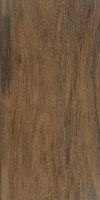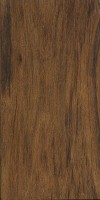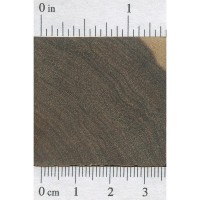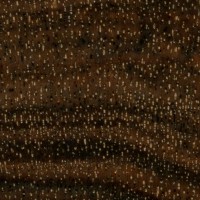 |
Common Name(s): Tambootie (variously spelled as: Tambuti, Tambotie, etc.), Sandalo Scientific Name: Spirostachys africana Distribution: Southern Africa Tree Size: 30-50 ft (9-15 m) tall, 1-1.5 ft (30-46 cm) trunk diameter Average Dried Weight: 60 lbs/ft3 (955 kg/m3) Specific Gravity (Basic, 12% MC): .81, .96 Janka Hardness: 2,480 lbf (11,010 N) Modulus of Rupture: 14,890 lbf/in2 (102.7 MPa) Elastic Modulus: 1,487,000 lbf/in2 (9.08 GPa) Crushing Strength: 8,920 lbf/in2 (61.5 MPa) Shrinkage: Radial: 2.8%, Tangential: 5.4%, Volumetric: 8.2%, T/R Ratio: 1.9 |
Color/Appearance: Color ranges from a golden brown to a darker reddish brown, often with black streaks throughout. Pale yellow sapwood sharply demarcated from heartwood. Occasionally figured pieces will be seen with subtle mottled grain patterns.
Grain/Texture: Tambootie has a straight grain (though occasionally it can be wavy) with a fine, even texture. Natural oils within the wood help give it a high natural luster.
Endgrain: Diffuse-porous; medium pores in no specific arrangement, moderately numerous to numerous; commonly in radial multiples of 2-4; heartwood gum deposits occasionally present; narrow rays not visible even with hand lens, spacing close; parenchyma generally not visible with hand lens.
Rot Resistance: Tambootie heartwood is rated as being very durable, and is also resistant to insect attack.
Workability: Overall, Tambootie has good working characteristics, and despite its high density, responds well to machining operations. However, blunting effect on cutters is medium to severe. Also, because of the presence of natural oils, the wood can be difficult to sand. Glues, turns, and finishes well, able to take on a high natural polish.
Odor: Tambootie has a lingering scent that’s been described as sweet and pleasing, though it is also quite strong.
Allergies/Toxicity: The sap from a standing Tambootie tree is highly irritating to the skin. The wood and sawdust has also been reported to cause eye and skin irritation. In extreme cases, there have been reports of blindness resulting from occupational exposure to Tambootie’s sawdust. The smoke generated from burning the wood is also toxic, and has been known to contaminate meats cooked over such firewood, resulting in diarrhea. See the articles Wood Allergies and Toxicity and Wood Dust Safety for more information.
Pricing/Availability: Tambootie is a relatively small tree, and is becoming less and less common because of its valuable wood. Prices are rather high for an imported African wood, though not as high as other exotic woods from the region, such as Pink Ivory or African Blackwood.
Sustainability: This wood species is not listed in the CITES Appendices or on the IUCN Red List of Threatened Species.
Common Uses: Carvings, furniture, turned objects, and other small, specialty wood items.
Comments: Tambootie is prized in Africa as a decorative hardwood, used for luxury furniture and other high end applications. It’s frequently used as a substitute for Sandalwood (which is a vague term that may encompass any number of aromatic wood species in Africa and Asia).
Tambootie is one of the few woods that ought to really be handled and worked with care, regardless of a person’s allergic resistance to other woods—its toxicity is well-known throughout its native range.
None available.
None available.
Scans/Pictures: A special thanks to Steve Earis for providing the wood sample of this wood species.
 |
 |
 |
 |





Processing – as it is written – poses risks, but treated wood still has a very distinct and unique smell for some time. In my opinion, it resembles the smell of expensive perfume and it is difficult to associate this smell with wood (no woody note), so I call this timber perfume wood ;-). Many African trees are colloquially called “sandalwood” (e.g. Muhuhu – beautiful, lasting aroma) also Tambootie.
Be extremely careful working this wood, always wear gloves a full face mask at all times.
You could get hill very quickly, don’t underestimate it.
P.S. I still keep a small board for my collection anyway.
Thanks for the warning, I always check on the wood database for any new wood that I use.
Have found this invaluable and a must.
I make pens and other turnings and I’m always looking for new species of wood to use.
I have quite a collection of exotic woods and all researched here